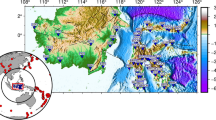Abstract
By analyzing teleseismic waveforms recorded by 53 stations of Hi-Climb profile passing through the central Bangong-Nujiang suture (BNS), a total of 4764 high- quality receiver functions are obtained. The average crustal thickness and Poisson’s ratio beneath each station are estimated using the travel time of Ps and PpPs of the Moho. The discontinuities such as the Moho, the 410- and 660-km interfaces are also studied using the common converted points (CCP) time to depth migration of receiver functions. The main results are as follows: (1) The Moho of Lhasa terrane and that of Qiangtang terrane nearby BNS are overridden and offset by ∼10 km. The structural geometry shows a northward uplifting and the southward deepening for the Moho of Lhasa terrane and Qiangtang terrane, respectively, which is related to the reactivated structure beneath BNS since Cenozoic era. (2) The variation range of Poisson’s ratios along the profile is between 0.237 and 0.280, indicating that the crust is mainly composed of felsic and intermediate rocks. The anti-correlation between the crustal thickness and Poisson’s ratio suggests that thicker crust beneath the southern Qiangtang terrane may be related to the successive thrust of felsic and intermediate rock of Lhasa terrane. (3) The thickness of the mantle transition zone along the profile remains about 255 km, implying that the tectonic activities caused by the India-Asia collision are confined to the depths above 410 km.
Similar content being viewed by others
References
Girardeau J, Marcoux J, Allegre C J, et al. Tectonic environment and geodynamic significance of the Neo-Cimmerian Donqiao ophiolite, Bangong-Nujiang suture zone, Tibet. Nature, 1984, 307: 27–31
Hirn A, Nercessian A, Sapin M, et al. Lhasa block and bordering sutures—A continuation of a 500-km Moho traverse through Tibet. Nature, 1984, 307: 25–27
Wittlinger G, Vergne J, Tapponnier P, et al. Teleseismic imaging of subducting lithosphere and Moho offsets beneath western Tibet. Earth Planet Sci Lett, 2004, 221: 117–130
Vergne J, Wittlinger G, Qiang H, et al. Seismic evidence for stepwise thickening of the crust across the NE Tibetan Plateau. Earth Planet. Sci Lett, 2002, 203: 25–33
Shi D, Zhao W, Brown L, et al. Detection of southward intracontinental subduction of Tibetan lithosphere along the Bangong-Nujiang suture by P-to-S converted waves. Geology, 2004, 32: 209–212
Kind R, Yuan X, Saul J, et al. Seismic images of crust and upper mantle beneath Tibet: evidence for Eurasian plate subduction. Science, 2002, 298: 1219–1221
Li Y H, Tian X B, Wu Q J, et al. The Poisson ration and crustal structure of the central Qinghai-Xizang inferred from INDEPTH-III teleseismic waveforms: Geological and geophysical implications(in Chinese). Chin J Geophys, 2006, 49: 1037–1044
Xiong S B, Liu H B. The crustal structure in western Tibetan Plateau (in Chinese). Chinese Sci Bull, 1997, 42: 1309–1312
Yuan X, Ni J, Kind R, et al. Lithospheric and upper mantle structure of southern Tibet from a seismological passive source experiment. J Geophys Res, 1997, 102: 27491–27500
Li X, Yuan X. Receiver functions in northeast China—implications for slab penetration into the lower mantle in northwest Pacific subduction zone. Earth Planet Sci Lett, 2003, 216: 679–691
Zhu L, Kanamori H. Moho depth variation in southern California from teleseismic receiver functions. J Geophys Res, 2000, 105: 2969–2980
Kosarev G, Kind R, Sobolev S V, et al. Seismic evidence for a detached Indian lithospheric mantle beneath Tibet. Science, 1999, 283: 1306–1309
Yuan X, Sobolev S V, Kind R, et al. Subduction and collision processes in the Central Andes constrained by converted seismic phases. Nature, 2000, 408: 958–961
Oreshin S, Kiselev S, Vinnik L, et al. Crust and mantle beneath western Himalaya, Ladakh and western Tibet from integrated seismic data. Earth Planet Sci Lett, 2008, 271: 75–87
Kumar P, Kind R, Priestley K, et al. Crustal structure of Iceland and Greenland from receiver function studies. J Geophys Res, 2007, 112, B03301, doi:10.1029/2005JB003991
Yuan X, Sobolev S V, Kind R. Moho topography in the central Andes and its geodynamic implications. Earth Planet Sci Lett, 2002, 199: 389–402
Tapponnier P, Xu Z, Roger F, et al. Oblique stepwise rise and growth of the Tibet plateau. Science, 2001, 294: 1671–1677
Zhang Z and Klemperer S L. West-east variation in crustal thickness in northern Lhasa block, central Tibet, from deep seismic sounding data. J Geophys Res, 2005, 110, B09403, doi:10.129/2004JB003139
Tian X, Wu Q, Zhang Z, et al. Joint imaging by teleseismic converted and multiple waves and its application in the INDEPTH-III passive seismic array. Geophys Res Lett, 2005, 32, L21315, doi: 10.1029/2005GL023686
Schulte-Pelkum V, Monsalve G, Sheehan A, et al. Imaging the Indian subcontinent beneath the Himalaya. Nature, 2005, 435: 1222–1225
Li Y H, Wu Q J, An Z H, et al. The poisson ration and crustal structure across the NE Tibetan Plateau determined from receiver functions(in Chinese). Chin J. Geophys, 2006, 49: 1359–1368
Xu L, Rondenay S, van der Hilst R. Structure of the crust beneath the southeastern Tibetan Plateau from teleseismic receiver functions. Phys Earth Planet Int, 2007, 165: 176–193
Zandt G, Ammon C J. Continental crust composition constrained by measurements of crustal Poisson’s ratio. Nature, 1995, 374: 152–154
Owens T J, Zandt G. Implications of crustal property variations for models of Tibetan Plateau evolution. Nature, 1997, 387: 37–43
Author information
Authors and Affiliations
Corresponding author
Additional information
This work was supported by the National Basic Research Program of China (Grant No. 2008CB425704)
About this article
Cite this article
Xu, Q., Zhao, J., Cui, Z. et al. Moho offset beneath the central Bangong-Nujiang suture of Tibetan Plateau. Chin. Sci. Bull. 55, 607–613 (2010). https://doi.org/10.1007/s11434-009-0387-9
Received:
Accepted:
Published:
Issue Date:
DOI: https://doi.org/10.1007/s11434-009-0387-9




